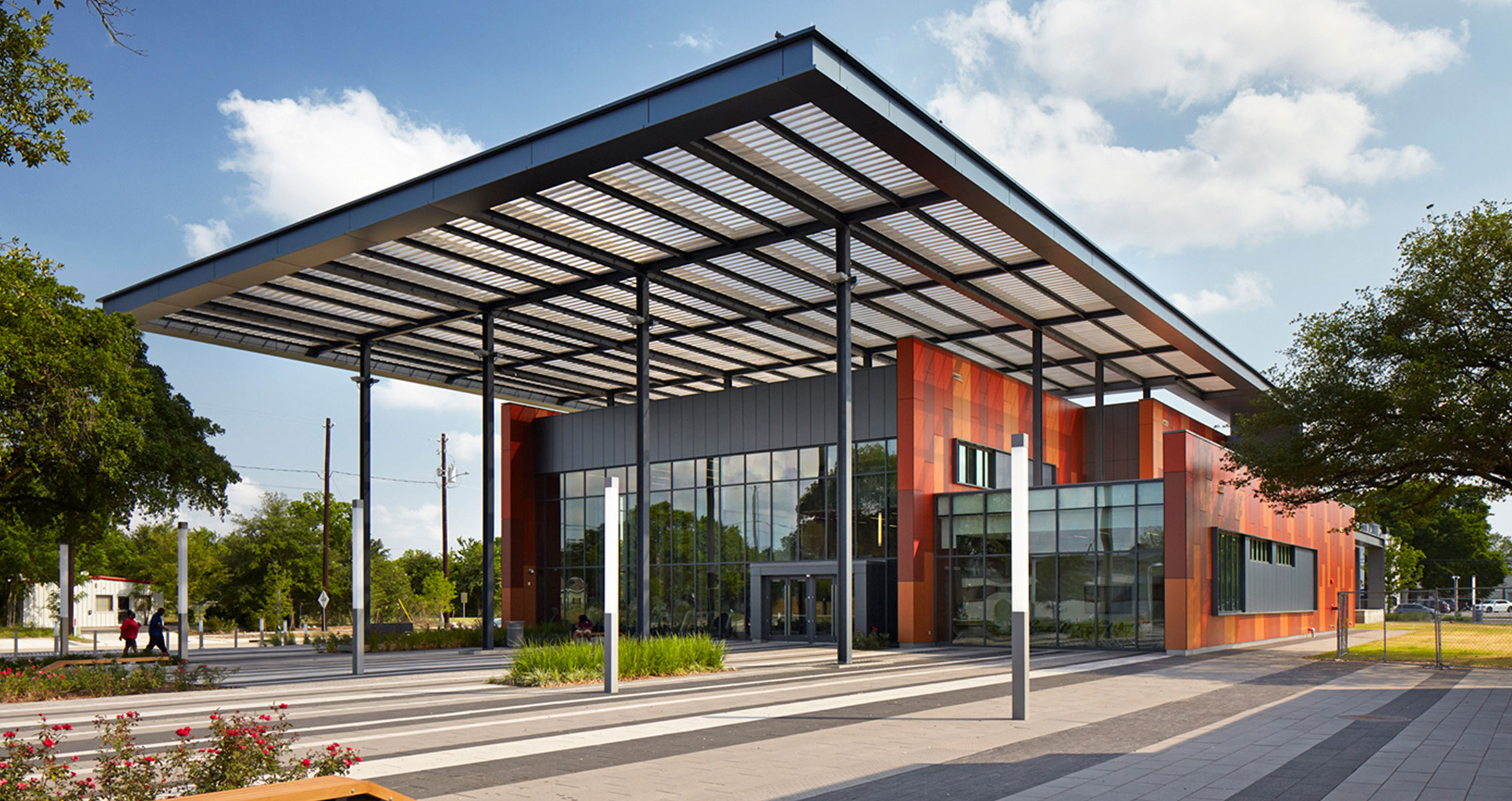Historic Emancipation Park, established in 1872 in Houston’s Third Ward community, will celebrate its grand reopening this month following a $33.6 million renovation designed by global architecture and design firm Perkins&Will. The newly-redesigned and rebuilt Park is an interwoven tapestry of buildings and landscape encompassing 10 acres in Houston’s Third Ward, the historic center of the African American community in Houston.
Historically, the park has hosted Houston’s Juneteenth celebration, the annual holiday commemorating June 19, 1865, the day when news of Emancipation and freedom reached Texas, more than two years after the Emancipation Proclamation was signed. Today, Juneteenth is observed in communities throughout the country. A grand reopening ceremony will be held June 17th as part of a weekend-long Juneteenth celebration June 17-19.
Community Partnership
The restoration was planned and designed in close collaboration with community partners OST/Almeda Corridors Redevelopment Authority, The Emancipation Park Conservancy, The Friends of Emancipation Park, and the City of Houston Parks and Recreation Department. ESPA of Houston served as the project manager, and M2L Associates of Houston was the landscape architect.
“The OST/Almeda Corridors Redevelopment Authority is elated to have had the opportunity to play a part in revitalizing this historic park, which remains as a major cultural focus within the Third Ward community and the city of Houston,” said Theola Petteway, the Authority’s Executive Director. “We recognize that it is helping to spark the redevelopment process within our community and help bring back businesses and residents to the area.”
Steeped in History
“We set out to honor both the historical story of Emancipation Park and the community’s vision for its future,” said Phil Freelon, FAIA, principal at Perkins&Will who led the planning and design team. “These two ideas came together thanks to a genuine collaboration, and countless conversations, planning sessions, research initiatives, and connections made with supporters of the project in the Third Ward and throughout the city.”
The Emancipation Park story Freelon cites began in 1872 when four formerly enslaved members of the Third Ward community pooled their funds to purchase 10 acres of open space for $800. The oldest public park in Texas, it was acquired by The City of Houston in 1918. The Park’s two original buildings, designed by prominent Houston architect William Ward Watkin, were built by the Works Progress Administration in 1938-39. For generations, the buildings and open spaces have hosted recreation, education, and social gatherings, and served as a unifying hub for community life in the Third Ward. Until the 1950s, it was the only public park and swimming pool in the city open to African Americans.
The renovation and restoration of Emancipation Park includes:
- New entry plaza to welcome visitors and provide information on the park and its daily activities
- New recreation center, complete with a gymnasium, basketball court, weight room, health center, classroom, lobby, server, kitchen, and reception area
- Two renovated and expanded historic buildings, the cultural center and the aquatic center. The old swimming pool at the aquatic center was removed and replaced with a modern pool
- The stage area, referred to as the Blessings Theater, was restored and provides space for small outdoor or indoor performances.
- New Event Lawn, a Founder’s Promenade, ball fields, outdoor courts, and family picnic areas
- A new children’s playground and interactive water features
Design Connects Past and Present
The design commemorates the Juneteenth celebration by creating a ceremonial gateway and promenade that add prominence to the annual occasion. The project also pays tribute to the four founders of the park with commemorative sculptural elements that include historical facts (currently being installed) at the four corners of the site.
The park’s central spine was established in the original 1939 site plan for Emancipation Park. Developed by landscape design firm Hare and Hare, it shows the main site axis running from Emancipation Avenue (formerly Dowling Street) to Hutchins Street. The new Founder’s Promenade is organized along this axis. The existing recreation center (now cultural center) and the Blessings Theatre, each critical to the history of Emancipation Park, anchor the Founder’s Promenade.
The new recreation center is clad in colored composite panels on the east and west facades. The rust and earth-tone colors of the panels represent a modern-day interpretation of the traditional metal roofs and brick masonry found in the neighborhood. Applied vertically, the panels add visual texture and a modern aesthetic to the building. The idea of connecting or stitching together many different parts to create a harmonious entity harkens back to African and African American traditions such as quilting. The “stitched” paving pattern amplifies the common central spine that links site and building elements.
Sustainability
The three buildings at Emancipation Park, two newly renovated and one newly built, together with the landscape restorations on the 10-acre site, are targeting LEED Certification or higher. Sustainable design features contributing to certification include:
- Geothermal energy system installed onsite to serve the mechanical systems of all three buildings
- Photovoltaic panel array on the recreation center roof will fulfill 35% of the building’s energy needs, qualifying for a LEED Exemplary Performance credit
- Sustainable site design and low-impact development principles includes site storm water management with pervious paving, bio swales, and underground water recycle/reuse
- Overall energy savings of 77% in the new construction building, qualifying for a LEED Exemplary Performance credit; overall energy savings of up to 40% for the two renovated buildings
